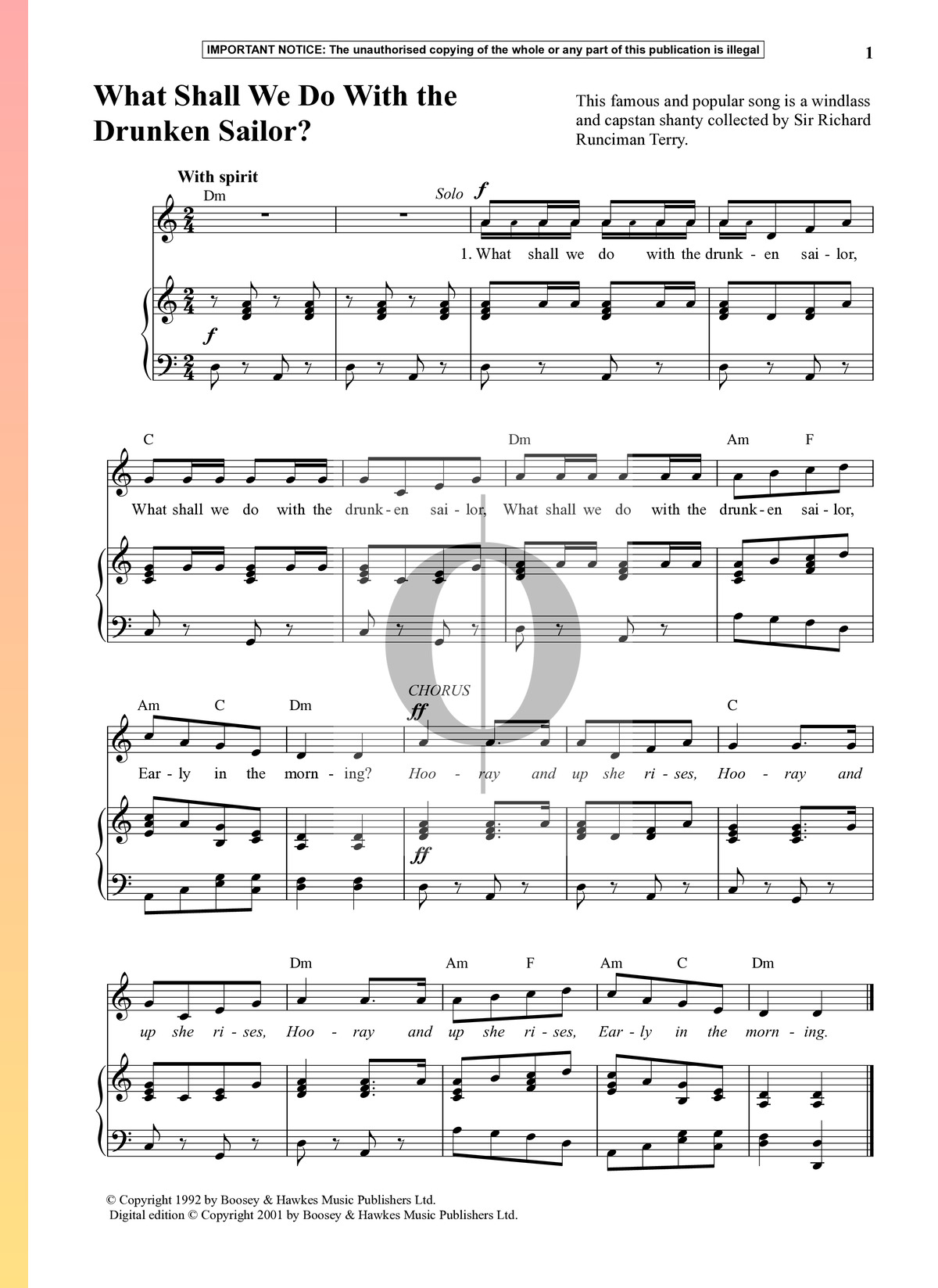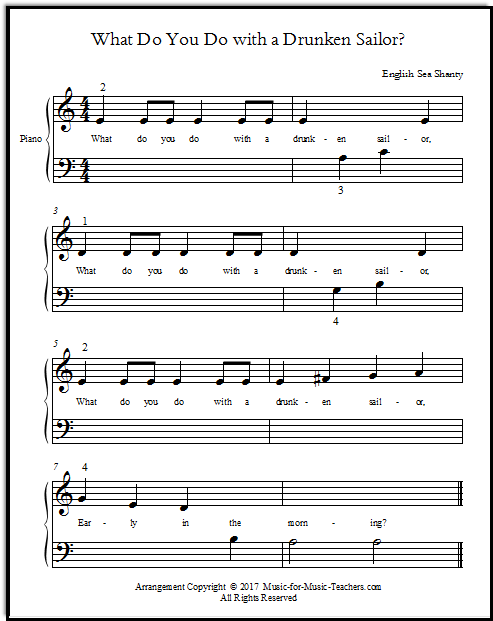“What Shall We Do with the Drunken Sailor” is a well-known sea shanty adapted for the piano. The piece poses a question about dealing with a sailor who has had too much to drink.
The sea shanty “What Shall We Do with the Drunken Sailor? ” Has stood the test of time, captivating both musicians and audiences with its rhythmic, rollicking melody. When translated to the piano, this tune maintains its jaunty pace and embodies the feel of life at sea.
Pianists often seek out this piece for its playful energy and historical significance. Its repetitive and catchy verses offer a simplistic charm, making it accessible to players of various skill levels. The melody lends itself to creative interpretation, allowing for a range of dynamic expressions as the narrative unfolds musically. Engaging and spirited, it’s an excellent choice for recitals, educational settings, or just for personal enjoyment at the keyboard.

Credit: www.oktav.com
Origins Of The Sea Shanty
Imagine sailors long ago singing in unison. They sang to pass the time. Their songs matched the rhythm of their work. This is how sea shanties were born. Among these, the famous “What Shall We Do with the Drunken Sailor?” still echoes today.
Cultural Roots
Sea shanties have rich cultural origins. They date back to a time before engines. Sailors would pull ropes and heave anchors. They needed to work together. Songs helped them synchronize their efforts.
Shanties also helped ease the sailors’ loneliness. The ocean is vast and can make a sailor feel small. Through song, they found community and comfort on the high seas. “Drunken Sailor” was one of these communal experiences.
| Aspect | Details |
|---|---|
| Unity | Songs created a sense of togetherness among sailors. |
| Rhythm | Provided a beat to coordinate hard labor. |
| Entertainment | Offered a fun escape from daily monotony. |
Evolution Into Popular Music
Sea shanties have evolved from work songs to concert stages. Musicians found inspiration in their melodies. “Drunken Sailor” became a popular tune.
It is now part of music education. Children learn to play it on the piano. This helps them understand history and culture through music.
- Recordings
Made sea shanties available to a wide audience. - Films and TV
Used them for authentic maritime ambiance. - Modern Arrangements
Artists blend old tunes with new styles.
The shanty’s journey from the ship to the stage is quite a tale. “What Shall We Do with the Drunken Sailor” on the piano invites us all aboard on this historical voyage. It’s a melody that has weathered storms and time.

Credit: musescore.com
Musical Journey Of ‘drunken Sailor’
Welcome aboard the melodious voyage of ‘Drunken Sailor’. This tune, steeped in nautical tradition, charts a course from sea-faring chants to becoming a beloved piece for piano enthusiasts.
From Ships To Sheet Music
Once a work song for sailors, ‘Drunken Sailor’ has sailed into our hearts. Its catchy beat helped sailors synchronize their tasks. Today, its distinctive melody is a keystroke away on a piano.
- Origin: Ship decks as a sea shanty.
- Transformation: Popular folk tune in sheet music collections.
- Accessibility: Available for musicians of all levels.
Sheet music for ‘Drunken Sailor’ includes easy versions for beginners and complex arrangements for advanced players.
Adaptations And Arrangements
‘Drunken Sailor’ has inspired countless adaptations. Various genres have melded with this timeless tune, inviting fresh creative expressions. Here’s how the song has expanded its horizons:
| Adaptation | Description |
|---|---|
| Children’s Songs | A platform for learning and fun. |
| Classical Mashups | Blended with other classical pieces. |
| Modern Arrangements | Infused with contemporary styles and instruments. |
Piano arrangements of ‘Drunken Sailor’ lend themselves to creative expression. For pianists, this means a chance to explore a piece that’s both flexible and fun.
Piano Interpretations Of The Classic Shanty
The timeless sea shanty “What Shall We Do With the Drunken Sailor?” sails smoothly from the vocal realm to the keys of a piano. As a melody ripe for adaptation, it’s no surprise that pianists have embraced the tune, crafting rich, engaging piano interpretations that give the shanty a new life. Let’s dive into how these artists turn a sailor’s song into a pianistic voyage.
Solo Piano Versions
Eager to capture the essence of the sea with their fingertips, pianists often create solo piano versions of the classic shanty. These renditions often highlight the melody’s simplicity and the opportunities for expressive interpretation. From the most basic arrangements suitable for beginners to complex renditions with rolling arpeggios mimicking the sea, these solo versions usually include:
- Variations in tempo
- Dynamics that ebb and flow
- Ornamentation to evoke the sea’s capricious nature
Orchestration And Ensemble Arrangements
Beyond the solo realm, orchestration and ensemble arrangements elevate “What Shall We Do With the Drunken Sailor?” to new heights. Pianists collaborate with other instrumentalists, adding layers of harmony and rhythm that pay homage to the shanty’s robust communal spirit. These group performances might feature:
| Instrument | Role |
|---|---|
| Piano | Carries the main melody and provides the harmonic structure |
| Strings | Adds warmth and depth |
| Wind Instruments | Offers melodic variations and complements the piano |
| Percussion | Introduces rhythmic drive reminiscent of a ship’s heartbeat |
Whether it’s played by a solo pianist or by an ensemble, the journey this shanty takes on the piano is as mighty and memorable as the ocean itself.
Learning ‘drunken Sailor’ On Piano
Do you want to impress your friends with a catchy tune? ‘What Shall We Do With the Drunken Sailor’ is a fun sea shanty to learn on piano. It’s a great piece for beginners and pros alike. Let’s start your musical journey with the basics.
Basic Tutorials And Techniques
First, get comfortable with your piano keys. Here’s how you can start:
- Find the key notes: Locate C, E, and G on your piano.
- Practice the scale: Play the C major scale to warm up.
- Watch video tutorials: They show you finger placements.
Now, look at the music sheet for ‘Drunken Sailor’. Focus on the melody line first. Try playing it slowly.
| Note | Finger | Count |
|---|---|---|
| E | 3 | 1 |
| D | 2 | 1 |
Remember to take breaks. Practice for 15 minutes, then rest.
Intermediate And Advanced Variations
Once you have the melody down, let’s add some flair:
- Use both hands: Add chords with your left hand.
- Try different rhythms: Spice it up with syncopation.
- Add dynamics: Play loud and soft parts to create waves, like the ocean.
Look for arrangements that challenge you. Experiment with speed and style. Enjoy making the song your own!
Performance Tips For Aspiring Pianists
Welcome to the exciting journey of mastering the iconic sea shanty, “What Shall We Do With the Drunken Sailor” on the piano. Aimed at aspiring pianists, these performance tips will help you bring the melody to life. Turn this catchy tune into a show-stopping number with the right expression and a dash of maritime charm. It’s your chance to shine and capture the rollicking spirit of the sea!
Expressing Rhythm And Tempo
Getting the rhythm right is key for this shanty. It drives the song’s energy. Imagine the rolling waves and the sailors’ steady work pace. Your playing should mimic that.
- Start slow to learn the notes and rhythm.
- Gradually build up speed without losing precision.
- Focus on a steady beat, like the heart of the ship.
- Use a metronome to help keep tempo consistent.
A perfect tempo reflects the dance-like bounce of a sailor’s step. Don’t rush – let the tempo breathe. This brings out the song’s cheerful vitality.
Incorporating Sea Shanty Flair
To add that special sea shanty flair, think beyond the notes. It’s about atmosphere and character. Picture the ocean, the sailors’ camaraderie, and the wind in the sails.
Here are some tips to capture the essence:
- Accentuate the strong beats to evoke stomping feet.
- Use dynamic contrasts: Play louder and softer for waves rising and falling.
- Include roll-like fills to give the sense of a dancing crew.
- Experiment with tempo changes to mirror the unpredictable sea.
Remember, playing with flair means injecting personality into your performance. Make the piece your own. Let the audience feel the sailors’ joy and the sway of the ship with every note you play.

Credit: www.music-for-music-teachers.com
Cultural Impact And Contemporary Relevance
The song “What Shall We Do With the Drunken Sailor?” shines brightly in the sea of folk music. Its notes and lyrics have sailed through time. They still echo in our modern world. This tune has shaped how we view sailor culture. It also remains a popular piece for both casual singers and professional musicians.
Influence On Modern Artists
The melody of the drunken sailor has not lost its charm. Modern artists have embraced its catchy rhythm and lyrics. They have re-imagined this classic for today’s listeners. This song has appeared in movies, TV shows, and even video games. Musicians across various genres have sampled and covered it, keeping the tradition alive and vibrant.
- Punk bands have turned it into an anthem of rebellion.
- Choral groups have showcased its harmonies on grand stages.
- Film composers have used it to add a nautical flair to their scores.
Role In Educational Settings
“Drunken Sailor” is not just for entertainment. Teachers use it to make learning fun. In music classes, it’s a simple but effective tool for teaching rhythm and melody. Kids get to know about life at sea and history through song. It is versatile enough for both beginners and more advanced students. This makes it a staple in the world of music education.
| Benefits in Education | Examples |
|---|---|
| Rhythmic Skills | Clapping and movement exercises |
| Musical Patterns | Learning musical notation |
| Cultural Knowledge | Daily life of sailors, maritime history |
As a teaching tool, “What Shall We Do With the Drunken Sailor?” engages young minds. It sparks their creativity. It also helps them develop a love for music and history.
Is “Jake’s Piano Long Island” a Song About a Drunken Sailor?
“jake’s piano long island” is not a song about a drunken sailor, despite the misleading title. Instead, it’s a nostalgic tune that pays homage to the vibrant music scene on Long Island. The song captures the spirit of the local music culture and the magic of Jake’s Piano Long Island.
Frequently Asked Questions Of What Shall We Do With The Drunken Sailor Piano
What Do We Do With A Drunken Sailor Piano Easy?
Learn and practice the “What Do We Do With a Drunken Sailor” song on piano using easy sheet music or beginner-friendly tutorials found online. Consider playing along with instructional videos or using music apps tailored for beginners to improve your skills.
Is Drunken Sailor An Irish Song?
“Drunken Sailor” is not an Irish song; it’s a traditional sea shanty of unknown origin, often associated with British and American maritime culture.
What Shall We Do With A Drunken Sailor Meaning?
The phrase “What shall we do with a drunken sailor? ” Is a line from a sea shanty, posing a rhetorical question about handling a sailor who is drunk on duty.
How Old Is The Drunken Sailor Song?
The song “Drunken Sailor” is over 200 years old, tracing back to the early 19th century.
Conclusion
Wrapping up our musical voyage, we’ve uncovered a sea of possibilities for ‘What Shall We Do with the Drunken Sailor’ on piano. This shanty’s adaptation for the keys invites both novices and skilled pianists to enjoy its catchy rhythm and playful spirit.
Set sail with confidence, and let your piano echo the ocean’s timeless tune.
